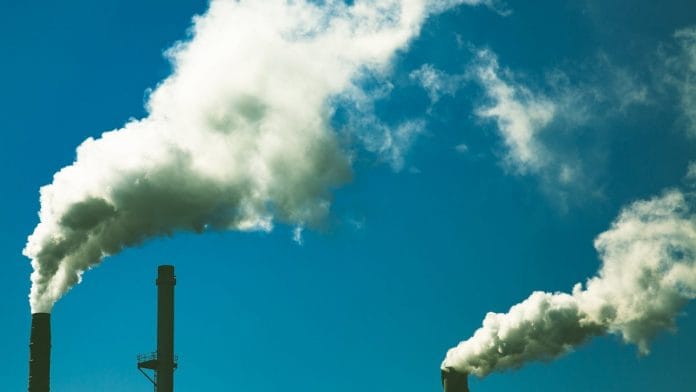For all the euphoria that rightly greeted Chinese President Xi Jinping’s announcement in September of a peak in carbon emissions by 2030 and a decline to net zero by 2060, the promise of that declaration is at risk.
To see why, consider Xi’s follow-up speech to the international Climate Ambition Summit on Dec. 12. While reiterating his earlier promises and fleshing them out with some additional pledges, it fell short on the most important point: How much China is prepared to spend decarbonizing its power system.
What Beijing does to turn around its carbon pollution in 2021 and over the coming decade matters more than in any other country. China already accounts for 29% of the world’s greenhouse emissions, double the U.S. share and three times that of the European Union. Once seen as a relatively low-polluting developing country, it’s now overtaking Europe in per-capita emissions, too.
What’s more, whereas carbon pollution in the U.S. and Europe is falling and down about 16% and 22% respectively from peaks in the mid-2000s — equivalent to about 1.55 billion metric tons of carbon dioxide — over the same period China’s toll has climbed 36%, or 2.45 billion tons, roughly equivalent to India’s total emissions.
Also read: What China’s pledge to be carbon neutral by 2060 means for big economies
The risk is that actions taken today to juice China’s economic growth will have repercussions far into the future. Carbon dioxide, once emitted, remains in the atmosphere for centuries. Fossil-fueled power stations and factories, once commissioned, acquire workforces and supply chains. Those will represent powerful interest groups in the years ahead, pushing against efforts to shut them down.
Xi’s latest speech indicates that these interest-group issues are already distorting priorities. The installed capacity of solar and wind power will rise to at least 1,200 gigawatts by 2030, he said, compared to 440GW at present. That represents pedestrian growth of around 76GW a year, roughly in line with installations during 2018.
The 2018 number was, to be sure, a record at the time, and China is by far the biggest developer of renewable power anywhere. Still, the planned pace is well below expectations of around 115GW a year from China’s solar and wind industry bodies, not to mention levels as high as 160GW that some analysts have expected to see in the 14th Five-Year Plan released next March. If China hits its economic targets, that slow pace of deployment all but guarantees that emissions from fossil power plants will continue to grow.
There’s no need for such timidity. Nearly all new wind and solar projects in China already provide cheaper power than new coal generation, and about half would be cheaper than keeping existing coal and gas plants running, according to BloombergNEF estimates. With less than a 10% share of electric power, there’s little need yet for energy storage to smooth out their variability. The only constraint on a much faster pace of rollouts should be the physical capacity to manufacture, install and connect so many gigawatts — and that’s where an ambitious target would help to clear bottlenecks.
Even if China ends up exceeding the 1,200GW number, by lowballing his renewables ambitions Xi is sending a message that the country is ready to take a fiscal and productivity hit — as well as harming the health of its citizens, and the planet’s climate — if it helps prop up smokestack industries that would be threatened by a faster move toward zero.
That’s the devil’s bargain in the modern Chinese economy. As we’ve written, for all the periodic talk of deleveraging, “build, baby, build” is as central to China’s growth model as it’s ever been. Only in Bhutan, Ireland and Turkmenistan is gross fixed capital formation — building stuff, essentially — a larger share of the economy than it is in China.
After slowing during the country’s most serious attempt to switch from investment to consumption in 2015, steel output has run ahead of economic growth every single year. A strong economy driving profitable metal production would be a good thing, but that pattern suggests the reverse is happening: Growth is being propped up by unproductive industrial boondoggles, storing up a vault of non-performing loans for the future.
The effect on the planet will be devastating. The surge in metal production to lift China from a Covid-induced slump has caused emissions to hit a record level in the third quarter and trashed longstanding plans to cut steel capacity, according to climate and energy analyst Lauri Myllyvirta. Perhaps 2021 will be different — but after so many reversals, promises of deleveraging should be given about as much credibility as an alcoholic’s vows to give up the bottle, as my colleagues Shuli Ren and Anjani Trivedi have written.
At some point, as with every credit-fueled boom, the river of cash will dry up and borrowers will have to work harder to justify their loans. The problem is that, right now, carbon-intensive projects are taking an outsize share of the soft money, despite their weaker economics and devastating health and environmental impacts. When policymakers finally switch to the cleaner investment they should be doing now, there’s no guarantee the necessary funds will still be available.
Beijing’s view of decarbonization looks like St. Augustine’s view of chastity: It wants to be pure, just not yet. The trouble is, if it doesn’t move fast, it may be too late — both for China and the planet.-Bloomberg
Also read: The secret origins of China’s 40-year plan to end carbon emissions






